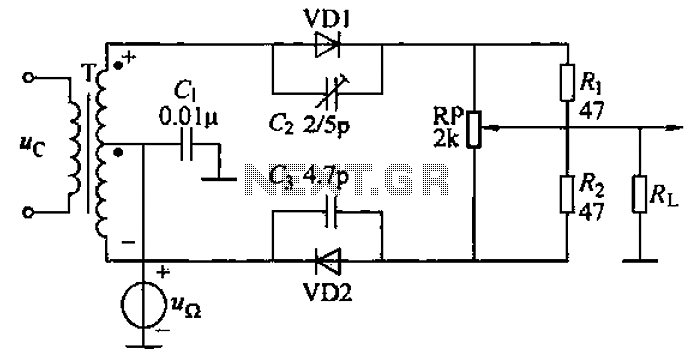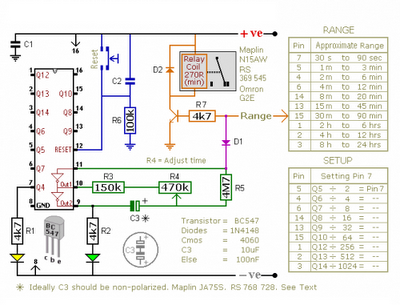
Crank Doorbell Circuit Schematic

This is an interesting hobby circuit for a crank doorbell. The circuit is built around a 555 timer and a musical piezo buzzer, powered by a 9-volt battery. A single 9-volt PP3/6F22 compact battery is sufficient to power the entire device. The timer IC (NE555) is configured in monostable mode to produce a timeout of several seconds. The output from the timer is directed to the piezo sounder through diode D1. Capacitor C2 functions as a buffer. The RC components R2 and C1 determine the timeout duration of the NE555 timer. A low-voltage small DC motor acts as the crank switch; in the prototype, a small disc motor from a discarded CD drive was utilized. Even a slight rotation of the motor shaft generates enough counter electromotive force (EMF) to energize the LED(s) inside the AC opto-coupler PS2505. This causes the phototransistor within the PS2505 to conduct, pulling down the trigger input (pin 2) of the NE555 IC. Consequently, a loud yet pleasant musical tone is emitted from the piezo sounder for a finite duration, approximately a few seconds. The musical buzzer can easily be replaced with an electromagnetic relay for switching external loads, with a 9-volt/600-ohm relay being preferred for this modification. Additionally, the circuit can serve as a security aid for two-wheelers, sensing wheel rotation of a parked vehicle and sounding an alarm to alert the owner. With some skill, the crank mechanism (such as a dynamo-wheel assembly) can be attached to any vehicle. However, for burglar alarm applications, a latching output circuit is highly recommended.
The circuit design utilizes a 555 timer in monostable mode, which is essential for generating a timed output pulse. The configuration allows the user to set a specific duration for the musical tone emitted by the piezo buzzer, controlled by the values of the resistors R2 and capacitor C1. The choice of a piezo buzzer is significant due to its efficiency and sound output capabilities, making it suitable for applications where auditory signals are necessary.
The crank switch mechanism, implemented via a small DC motor, serves as the activation point for the circuit. This innovative approach allows the circuit to be activated by physical movement, which is particularly useful in applications such as doorbells and alarms. The use of the PS2505 opto-coupler enhances the circuit's isolation between the mechanical and electronic components, ensuring that the activation of the buzzer does not interfere with the motor's operation.
For applications involving external loads, the option to replace the piezo buzzer with an electromagnetic relay broadens the circuit's functionality. This modification allows for the control of higher power devices, making it versatile for various electronic projects. The recommended 9-volt/600-ohm relay provides a suitable balance between power consumption and performance.
In security applications, the circuit's ability to detect wheel rotation and activate an alarm adds a layer of safety for parked vehicles. The adaptability of the crank mechanism ensures that this circuit can be integrated into various vehicles with minimal modifications. The recommendation for a latching output circuit in burglar alarm applications highlights the importance of reliable performance in security systems, ensuring that once triggered, the alarm remains active until manually reset.
Overall, this hobby circuit exemplifies creativity in electronics, combining basic components to create functional and practical applications in everyday scenarios.Here is an interesting hobby circuit of a crank door bell! The circuit is built around a timer 555 and a musical piezo-buzzer. The circuit works off 9 volt battery supply. One 9volt PP3/6F22 compact battery is enough for powering the whole gadget. Timer IC (NE555) is wired in monostable mode to produce a time out o some seconds. The output of t he timer is fed to the input of the piezo sounder through a diode D1. Capacitor C2 works as a buffer. RC components R2, C1 sets the monotimeout of the timer IC NE555. An ordinary low voltage small dc motor is here used as the crank switch. In prototype, one small disc motor from a discarded cd drive (optical deck) was used. Even a slight rotation of the motor shaft will produce sufficient counter emf to enegize the LED(S) inside the ac opto-coupler PS2505. As a consequence, phototransistor inside PS2505 conducts and there by it pull down the trigger input (pin2) of IC NE555.
The result is a loud but pleasing musical tone output from the piezo sounder for a finite duration, here around seconds. One can easily replace the musical buzzer with an EM relay for switching external loads. A 9 volt/600 Ohm relay is preferred for this modification. The circuit can also be used as a two wheeler security aid which senses the wheel rotation of a parked vehicle and sounds an alarm to alert the owner.
With a little skill, one can easily attach the crank mechanism (like the dynamo-wheel assembly) to any vehicle. However, for burglar alarm application, a latching output circuit is highly recommended. We aim to transmit more information by carrying articles. Please send us an E-mail to wanghuali@hqew. net within 15 days if we are involved in the problems of article content, copyright or other problems.
We will delete it soon. 🔗 External reference
The circuit design utilizes a 555 timer in monostable mode, which is essential for generating a timed output pulse. The configuration allows the user to set a specific duration for the musical tone emitted by the piezo buzzer, controlled by the values of the resistors R2 and capacitor C1. The choice of a piezo buzzer is significant due to its efficiency and sound output capabilities, making it suitable for applications where auditory signals are necessary.
The crank switch mechanism, implemented via a small DC motor, serves as the activation point for the circuit. This innovative approach allows the circuit to be activated by physical movement, which is particularly useful in applications such as doorbells and alarms. The use of the PS2505 opto-coupler enhances the circuit's isolation between the mechanical and electronic components, ensuring that the activation of the buzzer does not interfere with the motor's operation.
For applications involving external loads, the option to replace the piezo buzzer with an electromagnetic relay broadens the circuit's functionality. This modification allows for the control of higher power devices, making it versatile for various electronic projects. The recommended 9-volt/600-ohm relay provides a suitable balance between power consumption and performance.
In security applications, the circuit's ability to detect wheel rotation and activate an alarm adds a layer of safety for parked vehicles. The adaptability of the crank mechanism ensures that this circuit can be integrated into various vehicles with minimal modifications. The recommendation for a latching output circuit in burglar alarm applications highlights the importance of reliable performance in security systems, ensuring that once triggered, the alarm remains active until manually reset.
Overall, this hobby circuit exemplifies creativity in electronics, combining basic components to create functional and practical applications in everyday scenarios.Here is an interesting hobby circuit of a crank door bell! The circuit is built around a timer 555 and a musical piezo-buzzer. The circuit works off 9 volt battery supply. One 9volt PP3/6F22 compact battery is enough for powering the whole gadget. Timer IC (NE555) is wired in monostable mode to produce a time out o some seconds. The output of t he timer is fed to the input of the piezo sounder through a diode D1. Capacitor C2 works as a buffer. RC components R2, C1 sets the monotimeout of the timer IC NE555. An ordinary low voltage small dc motor is here used as the crank switch. In prototype, one small disc motor from a discarded cd drive (optical deck) was used. Even a slight rotation of the motor shaft will produce sufficient counter emf to enegize the LED(S) inside the ac opto-coupler PS2505. As a consequence, phototransistor inside PS2505 conducts and there by it pull down the trigger input (pin2) of IC NE555.
The result is a loud but pleasing musical tone output from the piezo sounder for a finite duration, here around seconds. One can easily replace the musical buzzer with an EM relay for switching external loads. A 9 volt/600 Ohm relay is preferred for this modification. The circuit can also be used as a two wheeler security aid which senses the wheel rotation of a parked vehicle and sounds an alarm to alert the owner.
With a little skill, one can easily attach the crank mechanism (like the dynamo-wheel assembly) to any vehicle. However, for burglar alarm application, a latching output circuit is highly recommended. We aim to transmit more information by carrying articles. Please send us an E-mail to wanghuali@hqew. net within 15 days if we are involved in the problems of article content, copyright or other problems.
We will delete it soon. 🔗 External reference





